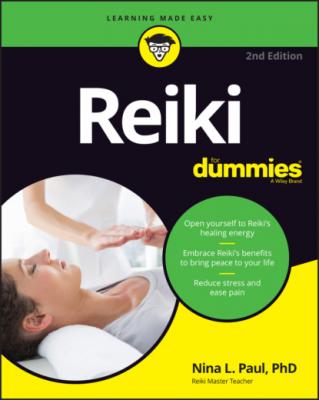ТОП просматриваемых книг сайта:
Reiki For Dummies. Nina L. Paul
Читать онлайн.Название Reiki For Dummies
Год выпуска 0
isbn 9781119894520
Автор произведения Nina L. Paul
Жанр Медицина
Издательство John Wiley & Sons Limited
Check out what types of Reiki classes are available in your area.
Speak to Reiki practitioners you know. Ask them what they liked and disliked about their classes or teachers.
Try out a Reiki session with a teacher you’re considering (either a private session or a Reiki circle).
Go to a Reiki circle or share in your community so you can see the styles of many teachers.
Speak to potential Reiki teachers and ask them the questions suggested in Chapter 7.
Letting Reiki Branches Differ
Variety of practice is almost built into the individualized way that Reiki was taught and passed on by Mikao Usui and Hawayo Takata.
Both Usui and Takata trained each student in a unique way:
Usui based his teachings on what he felt would be best for each student and the student’s particular spiritual level. For example, some students received symbols, and some did not.
Takata reportedly didn’t allow students to take notes. When they gathered after she died, the students were shocked to find that each had been given different variations of the teachings.
When Hawayo Takata died, she didn’t have a clear successor. Eventually Barbara Weber Ray (the Radiance Technique) and Phyllis Lei Furumoto (Hawayo Takata’s granddaughter) each claimed to be the successor. The Reiki Alliance called Furumoto the “lineage bearer” and “grandmaster.”
The lack of either a consistent and universal teaching or creation of one official school to carry on each of their Reiki systems led the successors of Mikao Usui, Chujiro Hayashi, and Hawayo Takata to each create their own versions or branches of Reiki practice. Because of these branches, interpretation of the Reiki system and practice varies.
Many varieties of Reiki have evolved from Western Reiki. Some incorporate New Age or other practices in addition to the simplicity of Usui’s original teachings. You can always inquire about the lineage to discover how a branch finds its way back to Mikao Usui.
Forecasting the Future of Reiki
Like a carpet of wildflowers, Reiki has spread worldwide with distinct branches and versions. Over time, some versions will thrive, and others will die out. The original seeds planted by Mikao Usui and then Chujiro Hayashi and Hawayo Takata have led to the expansion of Reiki, which continues to grow.
Chapter 4
Looking at the Reiki Principles
IN THIS CHAPTER
The five Reiki Principles form the cornerstone of what’s essentially a Reiki spiritual practice. All branches of Reiki derived from Mikao Usui’s teachings (see Chapter 3) use some version of the Reiki Principles. They may be called Reiki Principles, Reiki Precepts, Reiki Ideals, or Reiki Gokai (in Japanese). These statements are used as guidelines to right living and spiritual development. When you use the Reiki Principles, you’re following directly in the footsteps of Mikao Usui. In this chapter, I describe the Reiki Principles: what they are and how to use them.
Describing the Reiki Principles
The Reiki Principles are so important and intrinsic to the practice of Reiki that they’re engraved on Mikao Usui’s tombstone. In the West, before Usui’s memorial stone was re-discovered and available in English, the Reiki Principles were taught in Western Reiki as instructed by Hawayo Takata. Once the Japanese translations were made, it brought more meaning and depth to working with the Reiki Principles.
Do not anger.
Do not worry.
Be grateful.
Do your work.
Be kind to others.
Staying in the present: Just for today
Today is really all that matters. Yesterday is over, and tomorrow hasn’t happened. If your thoughts and energy are in the past or future, there’s little time left to experience the present. When you’re not fully focused on today, you may feel life is passing you by.
Filling too much time with reminiscing, looking at old photos, and wondering “what if?” is living in the past. Sitting with your daily planner

